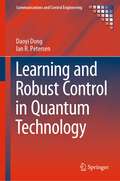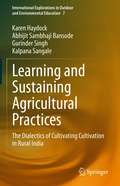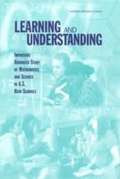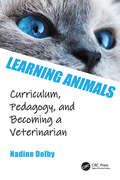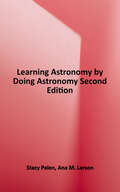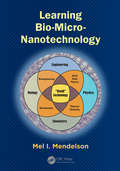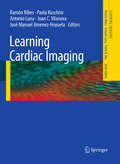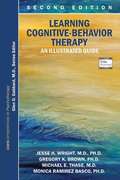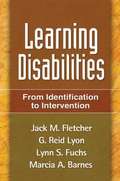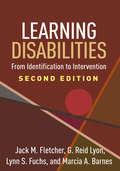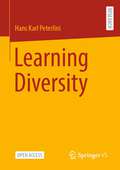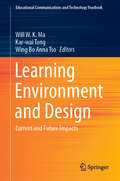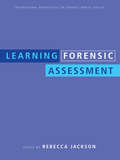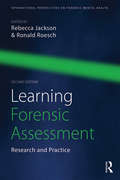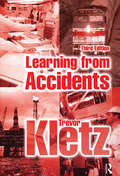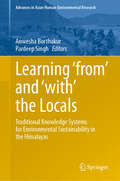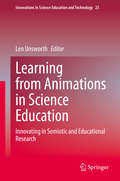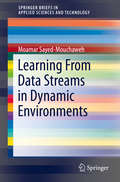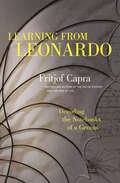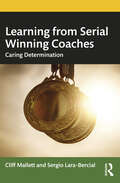- Table View
- List View
Learning and Memory: From Brain to Behavior (Second Edition)
by Mark A. Gluck Eduardo Mercado Catherine E. MyersDevelopments in neuroscience have changed the field of learning and memory significantly in the last ten years. This comprehensive introduction to learning and memory covers behavioural processes, brain systems, and clinical perspectives.
Learning and Robust Control in Quantum Technology (Communications and Control Engineering)
by Daoyi Dong Ian R. PetersenThis monograph provides a state-of-the-art treatment of learning and robust control in quantum technology. It presents a systematic investigation of control design and algorithm realisation for several classes of quantum systems using control-theoretic tools and machine-learning methods. The approaches rely heavily on examples and the authors cover:sliding mode control of quantum systems;control and classification of inhomogeneous quantum ensembles using sampling-based learning control;robust and optimal control design using machine-learning methods;robust stability of quantum systems; and H∞ and fault-tolerant control of quantum systems. Both theoretical algorithm design and potential practical applications are considered. Methods for enhancing robustness of performance are developed in the context of quantum state preparation, quantum gate construction, and ultrafast control of molecules.Researchers and graduates studying systems and control theory, quantum control, and quantum engineering, especially from backgrounds in electrical engineering, applied mathematics and quantum information will find Learning and Robust Control in Quantum Technology to be a valuable reference for the investigation of learning and robust control of quantum systems. The material contained in this book will also interest chemists and physicists working on chemical physics, quantum optics, and quantum information technology.
Learning and Sustaining Agricultural Practices: The Dialectics of Cultivating Cultivation in Rural India (International Explorations in Outdoor and Environmental Education #7)
by Karen Haydock Abhijit Sambhaji Bansode Gurinder Singh Kalpana SangaleThis book describes a participatory case study of a small family farm in Maharashtra, India. It is a dialectical study of cultivating cultivation: how paddy cultivation is learnt and taught, and why it is the way it is. The paddy cultivation that the family is doing at first appears to be ‘traditional’. But by observation and working along with the family, the authors have found that they are engaging in a dynamic process in which they are questioning, investigating, and learning by doing. The authors compare this to the process of doing science, and to the sort of learning that occurs in formal education. The book presents evidence that paddy cultivation has always been varying and evolving through chance and necessity, experimentation, and economic contingencies. Through the example of one farm, the book provides a critique of current attempts to sustain agriculture, and an understanding of the ongoing agricultural crisis.
Learning and Teaching Primary Science
by Angela FitzgeraldLearning and Teaching Primary Science brings primary science to life through the stories and experiences of pre-service and practising teachers. It explores the roles of the teacher and the learner of science and examines major issues and challenges, including: engaging diverse learners, utilising technology, assessment and reporting, language and representation, and integration in the 'crowded curriculum'. Each chapter contains examples, activities and reflective questions to help readers create relevant and meaningful lesson plans. Dedicated chapters for the areas of chemistry, physics, biology and earth and environmental science will give confidence to those without a science background. Practical strategies and skills are underpinned by relevant theories and evidence-based research. Written by experts from Australia and New Zealand, Learning and Teaching Primary Science is an essential resource for those beginning their journey of teaching science in the primary school classroom.
Learning and Teaching Tools for Basic and Clinical Respiratory Physiology
by Kin Kheong Mah Hwee Ming ChengThis volume synthesizes pathways in respiratory mechanics and the dynamics of air-blood and blood-cellular gas exchange for students and teachers in respiratory physiology. The authors strive to make physiology fun to learn. This aspect of knowledge acquisition is reflected in the way topics are approached, for example by using playing cards in what is coined 'Respi-CARDology'. The first section of this book reviews the framework and foundations of basic respiratory physiology. Since this book was not written to be a comprehensive physiology text, the authors have focused on leading students to appreciate and understand integrative principles and homeostatic mechanisms in lung function. The second section of this book mainly deals with the clinical application of fundamental knowledge of respiratory physiology.
Learning And Understanding: Improving Advanced Study Of Mathematics And Science In U.s. High Schools
by Committee on Programs for Advanced Study of Mathematics Science in American High SchoolsThis book takes a fresh look at programs for advanced studies for high school students in the United States, with a particular focus on the Advanced Placement and the International Baccalaureate programs, and asks how advanced studies can be significantly improved in general. It also examines two of the core issues surrounding these programs: they can have a profound impact on other components of the education system and participation in the programs has become key to admission at selective institutions of higher education.By looking at what could enhance the quality of high school advanced study programs as well as what precedes and comes after these programs, this report provides teachers, parents, curriculum developers, administrators, college science and mathematics faculty, and the educational research community with a detailed assessment that can be used to guide change within advanced study programs.
Learning Animals: Curriculum, Pedagogy and Becoming a Veterinarian
by Nadine DolbyWe are surrounded by thousands of animals, alive and dead. They are an intimate and ever-present part of our human lives. As a society, we privilege veterinarians as experts on these animals: they are our educators and teachers in what they say, what they do, and the decisions that they make. Yet, within the field of education, there is little research on the curriculum, pedagogy, and experiences of veterinary school and students. What do veterinarians learn in veterinary school? How do their experiences during those four years shape their perceptions of animals? How do the structures, curriculum, and pedagogy of veterinary college create and influence these experiences? Learning Animals opens up this conversation through an exploration of the complicated, fascinating and often painful stories of a cohort of veterinary students as they make their four-year journey from matriculation through graduation. The book examines how the experiences of veterinary students shape how humans relate to animals, from public policy and decision-making about the environment and animals slaughtered for food, to the most personal decisions about euthanizing companion animals. The first full-length, critical, qualitative study of the perspectives of our primary teachers about animals, this will be a thought-provoking read for those in the fields of both educational research and veterinary education.
Learning Astronomy by Doing Astronomy: Collaborative Lecture Activities, Second Edition
by Stacy Palen Ana M. LarsonResearch shows that students learn best by doing. This workbook, written by two master teachers, contains 36 field-tested activities, including nine new to the Second Edition, that span the introductory astronomy course and can be used in any size classroom. Each activity is now self-contained with an introduction that provides necessary background material for students. Activities are built around a concept that leads students from basic knowledge to a deeper understanding through guided interactions. The Second Edition is supported by Smartwork5, so instructors can easily assess student understanding.
Learning Bio-Micro-Nanotechnology
by Mel I. MendelsonLearning Bio-Micro-Nanotechnology is a primer on micro/nanotechnology that teaches the vocabulary, fundamental concepts, and applications of micro/nanotechnology in biology, chemistry, physics, engineering, electronics, computers, biomedicine, microscopy, ethics, and risks to humankind. It provides an introduction into the small world with a low fo
Learning Cardiac Imaging
by Joan C. Vilanova Ramón Ribes Antonio Luna José Manuel Jimenez-Hoyuela Paola KuschnirThis book is an introduction to cardiac imaging. Written by radiologists, cardiologists, and nuclear medicine physicians in a user-friendly format, it provides the reader with a multidisciplinary selection of the most prevalent cardiac conditions. The book is subdivided into four sections: Cardiac Multislice CT, Echocardiography, Cardiac Magnetic Resonance and Nuclear Cardiology. Each chapter is presented with an introduction to the subspecialty and a selection of cases with illustrations, comments from clinical and radiological standpoints, and bibliographical recommendations.
Learning Chest Imaging
by John C. Pedrozo PupoRadiology of the thorax forms an indispensable element of the basic diagnostic process for many conditions and is of key importance in a variety of medical disciplines. This user-friendly book provides an overview of the imaging techniques used in chest radiology and presents numerous instructive case-based images with accompanying explanatory text. A wide range of clinical conditions and circumstances are covered with the aim of enabling the reader to confidently interpret chest images by correctly identifying structures of interest and the causes of abnormalities. This book, which will be an invaluable learning tool, forms part of the Learning Imaging series for medical students, residents, less experienced radiologists, and other medical staff.
Learning Cognitive-Behavior Therapy: An Illustrated Guide (Core Competencies in Phychotherapy Ser.)
by Jesse H. Wright Monica Ramirez Basco Michael E. Thase Gregory K. Brown Glen O. GabbardBuilding on its successful -read-see-do- approach, this second edition of Learning Cognitive-Behavioral Therapy: An Illustrated Guide seamlessly combines 23 all-new videos with informative text and figures, charts, worksheets, checklists, and tables to help readers not only learn the essential skills of CBT but achieve competence in this important evidence-based treatment method. <P><P>Opening with an overview of core cognitive-behavior therapy (CBT) theories and techniques, leading CBT practitioners then describe and demonstrate how to build effective therapeutic relationships with CBT, conceptualize a case with the CBT model, structure sessions, and resolve common problems encountered in CBT. <P><P>This updated, second edition of the best-selling and highly popular Learning Cognitive-Behavioral Therapy also features: - Ways to employ CBT to reduce suicide risk- Guidance on integrating therapies related to CBT -- including dialectical behavior therapy, mindfulness-based cognitive therapy, and well-being therapy -- in the context of personality disorders and chronic or recurrent depression- An appendix of curated resources by the expert authors -- recommended readings, computer programs, Web sites, videos, and organizations -- to give readers access to the best resources in building competence in CBT practice <P><P>The all-new videos feature clinicians demonstrating methods in real-world settings and include new topics such as safety planning and uncovering and changing maladaptive schemas. Proven as one of the best teaching tools for building competence in CBT, this new edition will enrich readers' understanding and practice of CBT.
Learning Disabilities: Contemporary Viewpoints
by Brian J. Cratty Richard L. GoldmanThis volume examines the field of learning disabilities and the education of learning disabled (LD) children through the eyes of several experts. Contributors bring to the book such diverse academic backgrounds as education, psychology, special education and medicine. The chapters, adapted from lectures given at the Landmark West School in California, include audience questions and responses. Chapters on new medications for the LD child, contemporary research on dyslexia and educational strategies for improving reading are complemented bychapters on social and emotional issues that affect the families of learning disabled children, adolescents and young adults.
Learning Disabilities
by G. Reid Lyon Jack FletcherEvidence based and comprehensive, this important work offers a new approach to understanding and intervening with students with learning disabilities. The authors--leading experts in neuropsychology and special education--present a unique model of learning disabilities that integrates the cognitive, neural, genetic, and contextual factors associated with these disorders. The volume addresses classification, assessment, and intervention for a range of disabilities involved in reading, mathematics, and written expression. With a focus on exploring the evolving scientific base of the field, as well as establishing effective educational practices, this book will serve as an essential text and an indispensable resource for school psychologists, neuropsychologists, special educators, and others who work with struggling learners.
Learning Disabilities, Second Edition: From Identification to Intervention
by Jack M. Fletcher G. Reid Lyon Lynn S. Fuchs Marcia A. BarnesReviewing the state of the science of learning disabilities (LDs) and describing effective educational practices, this authoritative volume has been significantly revised and expanded with more than 70% new material. Foremost LD experts identify effective principles of assessment and instruction within the framework of multi-tiered systems of support (MTSS). With a focus on what works in the classroom, the book explores the full range of reading, mathematics, and writing disabilities. It synthesizes knowledge from neuropsychology, cognitive neuroscience, and special and general education. Illustrations include eight color plates. As a special supplement, a chapter on the history of the LD field from the first edition is provided at the companion website. New to This Edition *Heightened emphasis on intervention, including significant new developments in reading comprehension and math. *Reflects major scientific advances in understanding LDs. *Chapter on principles of effective instruction and MTSS. *Chapter on automaticity in reading, math, and writing. *Chapter on challenges in real-world implementation of evidence-based practices. *Chapter on the validity of the LD construct.
Learning Diversity
by Hans Karl PeterliniThis Open-Access-book explores diversity in its ambivalence. On the one side, we love to describe diversity as a resource for personal, social, economic, and cultural growth. On the other side, categories of differences often lead to discrimination or serve as justifications for privileges. They can cause exclusion and, conversely, promote the self-constitution of discriminated subjects and groups.The book moves within this tension of exclusion and belonging. Case studies of young ethnicized people vividly depict the interwovenness of identity-building and diversity. Theoretically, the book examines the psychosocial and anthropological conditions for constructing the Other. Sharp divisions between We and the Other, between social and national groups, and between humans and nature have devastating, life-threatening consequences. Dichotomous split-offs divide people, nations and the whole world. So, how do we deal with diversity? The author does not provide simple recipes but engages in a phenomenology of diversity that does not press life and its manifestations into categories but keeps them in a limbo of attention by affirming and doubting differences.
Learning Environment and Design: Current and Future Impacts (Educational Communications and Technology Yearbook)
by Will W. K. Ma Kar-Wai Tong Wing Bo Anna TsoThis special edition of the Educational Communications and Technology Yearbook Series bears a title of “Learning Environment and Design: Current and Future Impact”. It provides a timely forum to share theoretical and practical insights in both the local and international contexts in response to the fact that new media and technologies have infiltrated and shaped the learning environments from mere physical spaces into multifaceted possibilities, impacting the ways individuals teach and learn. Designs of learning environments to harness technologies appropriately to engage learners better, as well as the roles of learners and educators play in this changing learning environment, are examples of important global issues in the discourse of the contemporary educational developments. Having gathered a diverse collection of research papers written by scholars and practitioners in the fields of education, communication and humanities across Asia, Australasia, Europe and the United States, this book gives readers a cross-cultural background on the developments of technological designs and educational practices, investigating areas in redefining of quality education; online learning and blended learning; new media in education; gamification, AI, and innovative learning technologies. Aimed to catalyze knowledge exchanges and provide fresh views on interdisciplinary research, the book sheds light on how emerging technologies can be adapted in the fields of education and communication, so as to facilitate the current and future designs of learning environments to improve learners’ performances.
Learning Forensic Assessment
by Rebecca JacksonProviding an excellent resource for forensic psychology undergraduate students, this book offers students the opportunity to learn from experts, through the collection of outstanding articles. Unlike other books in the area that are topic specific, it also gives them comprehensive coverage of the subject. Divided into five broad topic areas, it covers: professional issues juvenile assessment criminal forensic assessment civil forensic assessment pervasive issues – malingering and psychopathy. Written by a group of internationally renowned contributors and including didactic information as well as providing discussions on practical issues regarding assessment and assessment instruments, this textbook will be invaluable reading for all students of forensic psychology.
Learning Forensic Assessment: Research and Practice (International Perspectives on Forensic Mental Health)
by Rebecca Jackson and Ronald RoeschMajor developments in the field since the publication of Learning Forensic Assessment are integrated in this revised edition, including revised editions of the DSM-5, HCR-20 scale, and child custody guidelines. This textbook is designed for graduate students learning forensic assessment and psychologists coming to forensic practice later in their careers. It is organized around five broad areas: Professional and Practice Issues, Adult Forensic Assessment, Juvenile Forensic Assessment, Civil Forensic Assessment, and Communicating Your Findings. Each chapter begins with a strong teaching and learning foundation. The latter part of each chapter is assessment specific, covering available assessment measures and approaches to assessment. The authors go well beyond simple descriptions of assessment measures and provide a conceptual discussion of the evaluation process that helps the reader understand how assessment measures fit into the overall evaluation process. The evaluation component is geared toward assessing the important aspects of the construct as laid out in the early part of each chapter. Each chapter then concludes with a case example to illustrate the measures and techniques described.
Learning from Accidents
by Trevor KletzReview of previous edition:"Trevor Kletz's book makes an invaluable contribution to the systematic, professional and scientific approach to accident investigation". The Chemical Engineer Fully revised and updated, the third edition of Learning from Accidents provides more information on accident investigation, including coverage of accidents involving liquefied gases, building collapse and other incidents that have occurred because faults were invisible (e.g. underground pipelines).By analysing accidents that have occurred Trevor Kletz shows how we can learn and thus be better able to prevent accidents happening again. Looking at a wide range of incidents, covering the process industries, nuclear industry and transportation, he analyses each accident in a practical and non-theoretical fashion and summarises each with a chain of events showing the prevention and mitigation which could have occurred at every stage. At all times Learning from Accidents, 3rd Edition emphasises cause and prevention rather than human interest or cleaning up the mess. Anyone involved in accident investigation and reporting of whatever sort and all those who work in industry, whether in design, operations or loss prevention will find this book full of invaluable guidance and advice.
Learning ‘from’ and ‘with’ the Locals: Traditional Knowledge Systems for Environmental Sustainability in the Himalayas (Advances in Asian Human-Environmental Research)
by Anwesha Borthakur Pardeep SinghThis book aims to capture the fading traditional knowledge systems of local and indigenous communities in the Himalayas. As many of these practices are at risk of disappearing, the book serves as a valuable record. It encourages readers to reflect on the implications of such knowledge for environmental sustainability today. Focusing on one of the most crucial mountain ranges globally, the book emphasizes the importance of learning ‘from’ and ‘with’ the locals about their lived experiences in the Himalayas. Understanding their unique set of traditional knowledge and technologies is crucial for building climate resilience and effective environmental management. With contributions from experts across the Himalayan region, the book strives for a comprehensive grasp of environmental challenges and potential solutions. Beyond documentation, the goal is to explore opportunities for integrating traditional knowledge with modern scientific approaches. Recognizing the urgency, the book advocates for the preservation of local and indigenous knowledge to address the ongoing global environmental crisis.
Learning from Animations in Science Education: Innovating in Semiotic and Educational Research (Innovations in Science Education and Technology #25)
by Len UnsworthThis book examines educational semiotics and the representation of knowledge in school science. It discusses the strategic integration of animation in science education. It explores how learning through the creation of science animations takes place, as well as how animation can be used in assessing student’s science learning. Science education animations are ubiquitous in a variety of different online sites, including perhaps the most popularly accessed YouTube site, and are also routinely included as digital augmentations to science textbooks. They are popular with students and teachers and are a prominent feature of contemporary science teaching. The proliferation of various kinds of science animations and the ready accessibility of sophisticated resources for creating them have emphasized the importance of research into various areas: the nature of the semiotic construction of knowledge in the animation design, the development of critical interpretation of available animations, the strategic selection and use of animations to optimize student learning, student creation of science animations, and using animation in assessing student science learning. This book brings together new developments in these research agendas to further multidisciplinary perspectives on research to enhance the design and pedagogic use of animation in school science education. Chapter 1 is available open access under a Creative Commons Attribution 4.0 International License via link.springer.com.
Learning from Data Streams in Dynamic Environments
by Moamar Sayed-MouchawehThis book addresses the problems of modeling, prediction, classification, data understanding and processing in non-stationary and unpredictable environments. It presents major and well-known methods and approaches for the design of systems able to learn and to fully adapt its structure and to adjust its parameters according to the changes in their environments. Also presents the problem of learning in non-stationary environments, its interests, its applications and challenges and studies the complementarities and the links between the different methods and techniques of learning in evolving and non-stationary environments.
Learning from Leonardo: Decoding the Notebooks of a Genius
by Fritjof CapraLeonardo da Vinci was a brilliant artist, scientist, engineer, mathematician, architect, inventor, writer, and even musician--the archetypal Renaissance man. But he was also, Fritjof Capra argues, a profoundly modern man. Not only did Leonardo invent the empirical scientific method over a century before Galileo and Francis Bacon, but Capra's decade-long study of Leonardo's fabled notebooks reveal him as a systems thinker centuries before the term was coined. He believed the key to truly understanding the world was in perceiving the connections between phenomena and the larger patterns formed by those relationships. This is precisely the kind of holistic approach the complex problems we face today demand. Capra describes seven defining characteristics of Leonardo da Vinci's genius and includes a list of over forty discoveries Leonardo made that weren't rediscovered until centuries later. Leonardo pioneered entire fields--fluid dynamics, theoretical botany, aerodynamics, embryology. Capra's overview of Leonardo's thought follows the organizational scheme Leonardo himself intended to use if he ever published his notebooks. So in a sense, this is Leonardo's science as he himself would have presented it. Leonardo da Vinci saw the world as a dynamic, integrated whole, so he always applied concepts from one area to illuminate problems in another. For example, his studies of the movement of water informed his ideas about how landscapes are shaped, how sap rises in plants, how air moves over a bird's wing, and how blood flows in the human body. His observations of nature enhanced his art, his drawings were integral to his scientific studies, and he brought art and science together in his extraordinarily beautiful and elegant mechanical and architectural designs. Obviously, we can't all be geniuses on the scale of Leonardo da Vinci. But by exploring the mind of the preeminent Renaissance genius, we can gain profound insights into how best to address the challenges of the 21st century.
Learning from Serial Winning Coaches: Caring Determination
by Cliff Mallett Sergio Lara-BercialLearning from Serial Winning Coaches provides performance coaches and directors, coach developers, and researchers with the knowledge and tools to affirm and challenge policy and practice and conduct further research to inform future policy and practice in the identification, recruitment, and development of performance coaches. Leading an athlete or team to an Olympic or world championship gold medal or professional league title is a great achievement for a coach; a dream that comes true for a small group of privileged coaches. This outstanding accomplishment can become the defining moment of their careers. Winning multiple golds and championships with different athletes or teams, and across multiple major events spanning decades, is the prerogative of an exclusive club of coaches. This book reveals the secrets, experiences, and practices of 17 of these coaches across 10 sports and 10 different countries. Through a combination of in-depth interviews with the coaches and their athletes and a detailed analysis of their personality and motivational profiles, Mallett and Lara-Bercial offer a unique portrait of the day-to-day workings of these coaches: who they are, how they operate, their leadership style, and their inimitable and often serendipitous journeys to the top of the sporting world. Learning from Serial Winning Coaches goes beyond the description of isolated coaching behaviours provided by previous research to explore the personal realities of these exceptional men and women, coaches, and athletes. The emerging multi-dimensional picture sheds light on the unique conditions and practices that lead to the unparalleled success of these true outliers. This book is key reading for researchers, coaching and coaching psychology students, performance coaches and directors, and coach developers, providing a novel evidence-based theoretical framework to conduct further research, shape and reshape coach development, and facilitate the identification and recruitment of the next generation of serial winners.

